Physical Address
304 North Cardinal St.
Dorchester Center, MA 02124
First described in the 1970s, awareness of neonatal hypertension has increased over the past several decades. Despite this, there is still uncertainty over which neonates require treatment for hypertension, primarily because of conflicting data on normative blood pressure (BP) values in neonates, and also because few reliable outcome data are available. This chapter will review the existing data on normal neonatal BP and will present a reasonable approach to evaluation and management based upon likely causes and pathophysiology. Finally, research needs, especially those related to late-onset hypertension and long-term outcome, will be reviewed.
There are many complexities to the changing patterns of BPs in the newborn period. Infant characteristics such as gestational age at birth, postnatal and postmenstrual age, as well as appropriateness of size for gestational age all influence BP. Maternal illnesses such as diabetes and other prenatal factors may also affect BP levels following delivery. As in older children, BP values in neonates may vary according to the method of BP assessment (e.g., intraarterial, Doppler, oscillometric) and also according to the infant’s state (e.g., sleeping, crying, feeding). All these factors need to be taken into account when reviewing the literature on BP standards, as well as when interpreting BP values in clinical practice. Even though neonatal BPs have been measured for decades, we are still in the early phase of identifying the normal patterns of infant BPs, and there are still many physiologic changes that need further investigation.
Data on BP from 329 infants on the first day of life were published in 1995 by Zubrow et al. They were able to define the mean BP plus upper and lower 95% confidence limits; their data clearly demonstrated increases in BP with increasing gestational age and birth weight ( Fig. 16.1 ). A more recent study by Pejovic et al., limiting their analysis to hemodynamically stable premature and term infants admitted to the neonatal intensive care unit (NICU), also showed that BPs on day 1 of life correlated with gestational age and birth weight. Healthy term infants do not seem to demonstrate this same pattern.
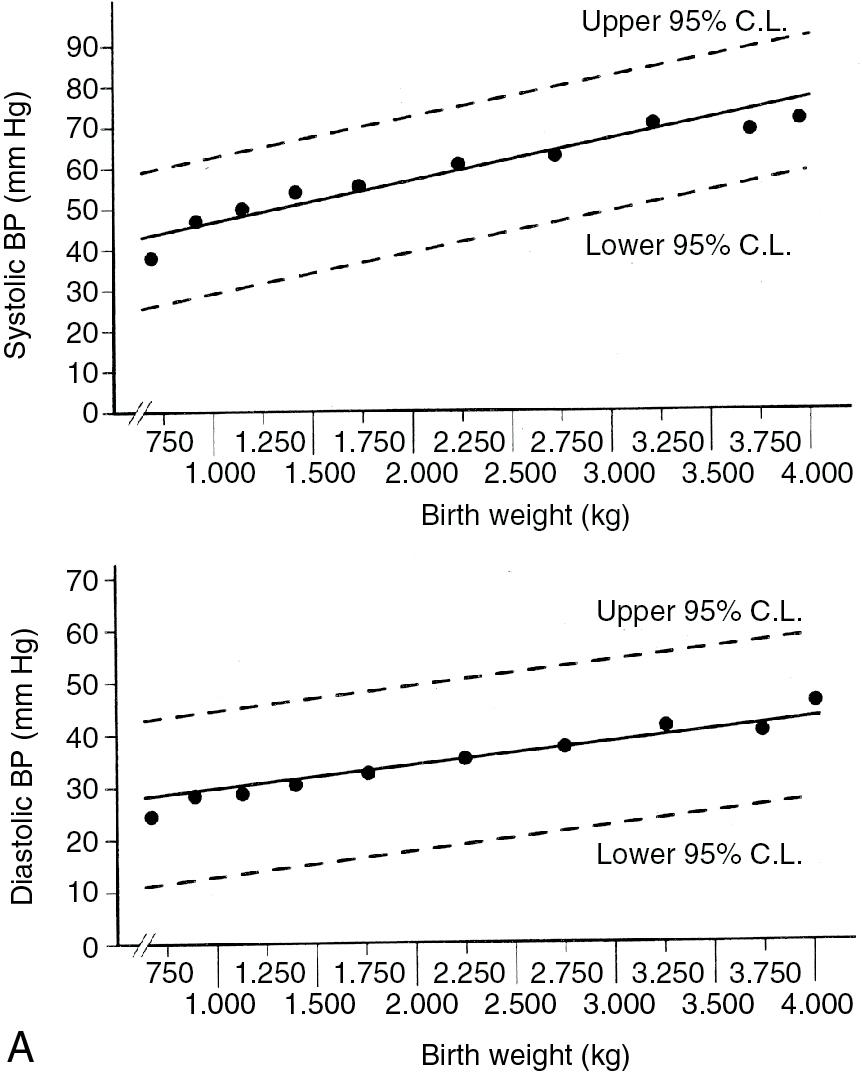
After the first day of life, it appears that BPs in premature newborns increase more rapidly over the first week or two of life, followed by a slowing of the rate of increase. The previously mentioned Philadelphia study categorized over 600 infants in the NICU into gestational age groups and showed a similar rate of BP increase over the first 5 days of life, regardless of gestational age. The more recent study by Pejovic and colleagues on stable NICU infants showed a similar pattern, with BPs in each gestational age category of premature infants increasing at a faster rate over the first week of life with subsequent slowing. In these infants, they determined that the rate of rise was more rapid in the preterm than full-term infants ( Fig. 16.2 ). As premature neonates mature, it appears that the strongest predictor of BP is postmenstrual age, as seen in Fig. 16.3 from Zubrow et al.
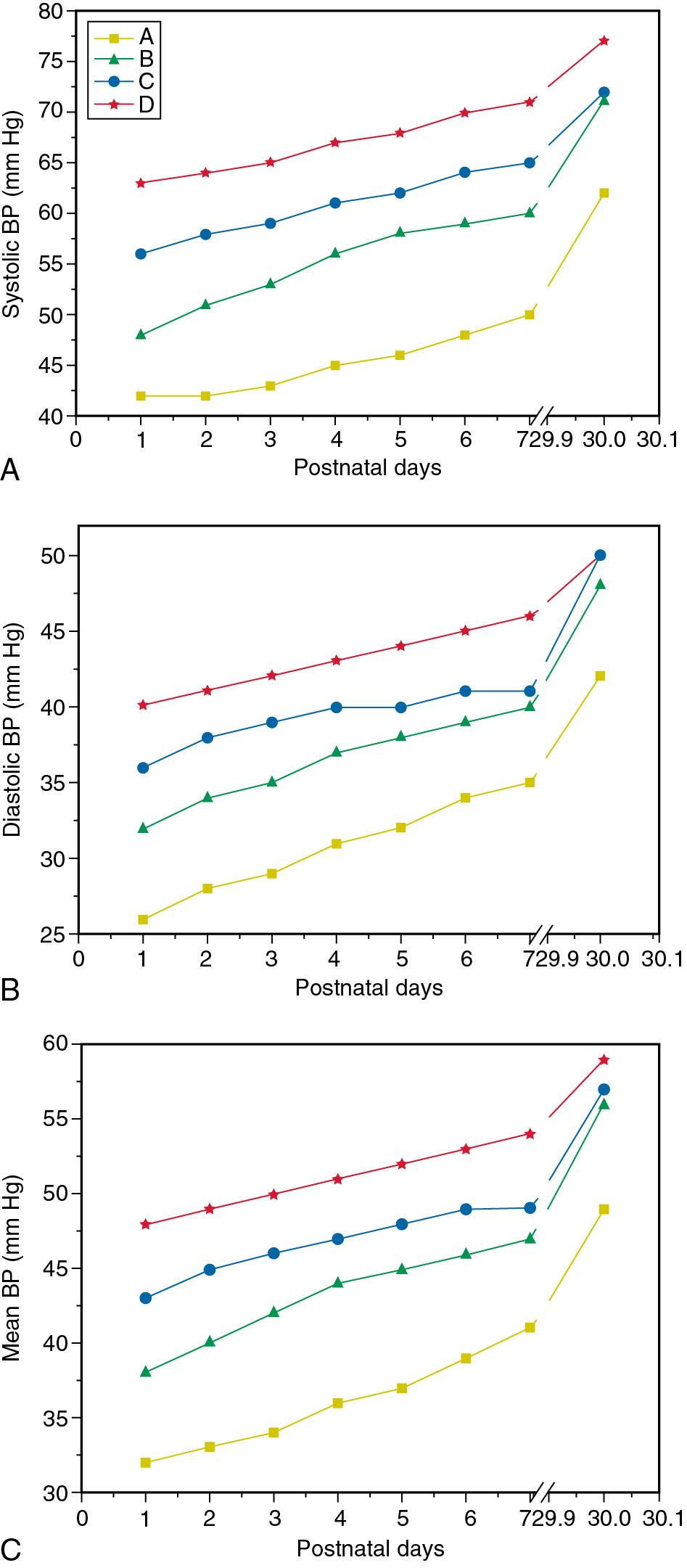
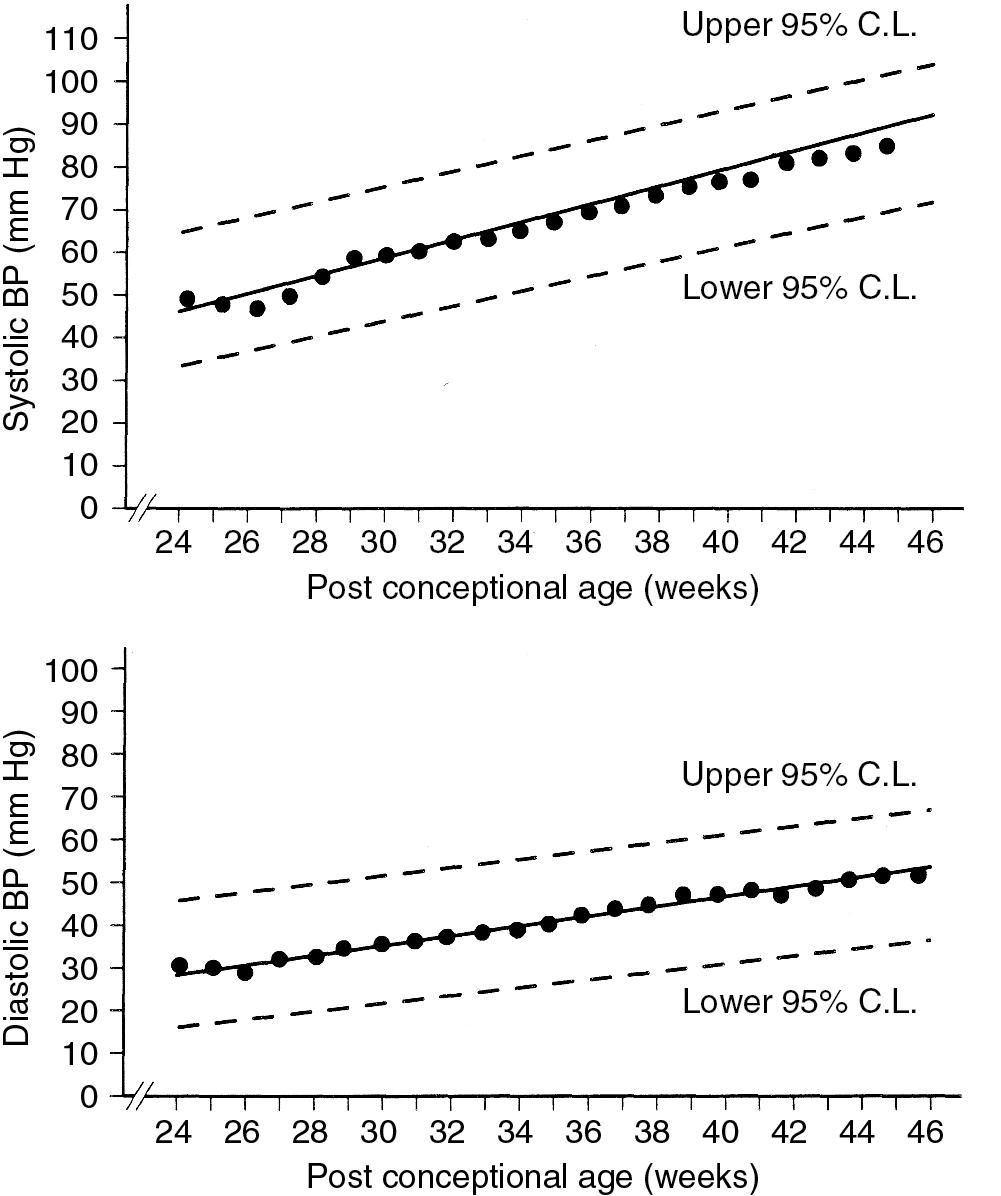
In term infants, appropriateness for gestational age seems to be an important influence on BP. In an Australian study of healthy term infants, BPs were higher on day 2 of life compared with day 1 but not thereafter. A correlation between birth weight and BP on day 3 of life was demonstrated in a large Japanese study of term infants ; this study also showed an increase in BP from days 2 through 4 of life, consistent with studies mentioned earlier. A Spanish study demonstrated that small for gestational age infants had the lowest BP at birth but subsequently the fastest rate of rise, so that by 1 month of age, all term infants had similar BPs. Fig. 16.4 summarizes the pattern of change in BP among the various subgroups of infants mentioned previously.
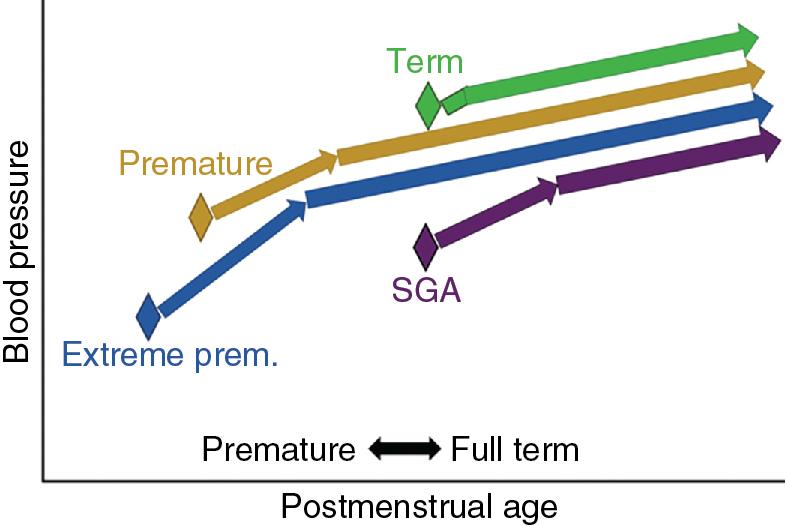
Genetic factors likely also play a role in determining BP, although limited studies have been completed to date. One study identified cytochrome P450 (CYP2D6) CC genotype as being associated with higher BPs in preterm infants during hospitalization and at neonatal follow-up. A more recent study of term infants in Poland demonstrated an association between the 1936A → G AKAP10 genotype and BP, with heterozygous and homozygous carriers of the 1936G variant having higher mean and diastolic BP than infants homozygous for 1936A. It is likely that additional genetic mutations with an effect on neonatal BP will be identified in the future.
Maternal factors, including medications, underlying illnesses, and adequacy of nutrition during pregnancy, can also influence a neonate’s BP. Higher infant BPs have correlated with maternal body mass index > 30 kg/m 2 and low socioeconomic status in Nigerian infants and in an Australian study to premature infants born to mothers with diabetes or neonates with abnormal uteroplacental perfusion by placental pathology. There is some suggestion in the literature that chorioamnionitis and HELLP (hemolysis, elevated liver enzymes, low platelets) syndrome may be related to lower infant BPs. A recent systematic review of the maternal factors that can influence BP in newborns came to the conclusion that not enough is known to draw definitive conclusions about the relative impact that each of these processes may have—although it is likely that neonatal BP is impacted by maternal factors, further study is required.
Normal BPs in infants older than 1 month have not been extensively studied recently. The percentile curves reported by the Second Task Force of the National High Blood Pressure Education Program ( Fig. 16.5 ) remain the most widely available reference values. These curves allow BP to be characterized as normal or high not only by age and gender, but also by length (provided in the legend below the curves). Unfortunately, these BP values were determined by a single measurement on awake infants by the Doppler method, which reduced the number of diastolic BP readings by more than half. Additionally, several more recent publications suggest that these BP values may be inaccurate. A study of 406 healthy term infants with BPs measured by the oscillometric method on day 2 of life and then at 6 and 12 months of age demonstrated BPs that are slightly higher than the Task Force values. Comparison with the more recently published values for 1-year-olds in the 2017 American of Academy of Pediatrics (AAP) guideline on childhood hypertension reveals significant differences that further call into question the validity of the 1987 curves. These issues highlight that there is clearly a pressing need for new normative BP data on infants during the first year of life.
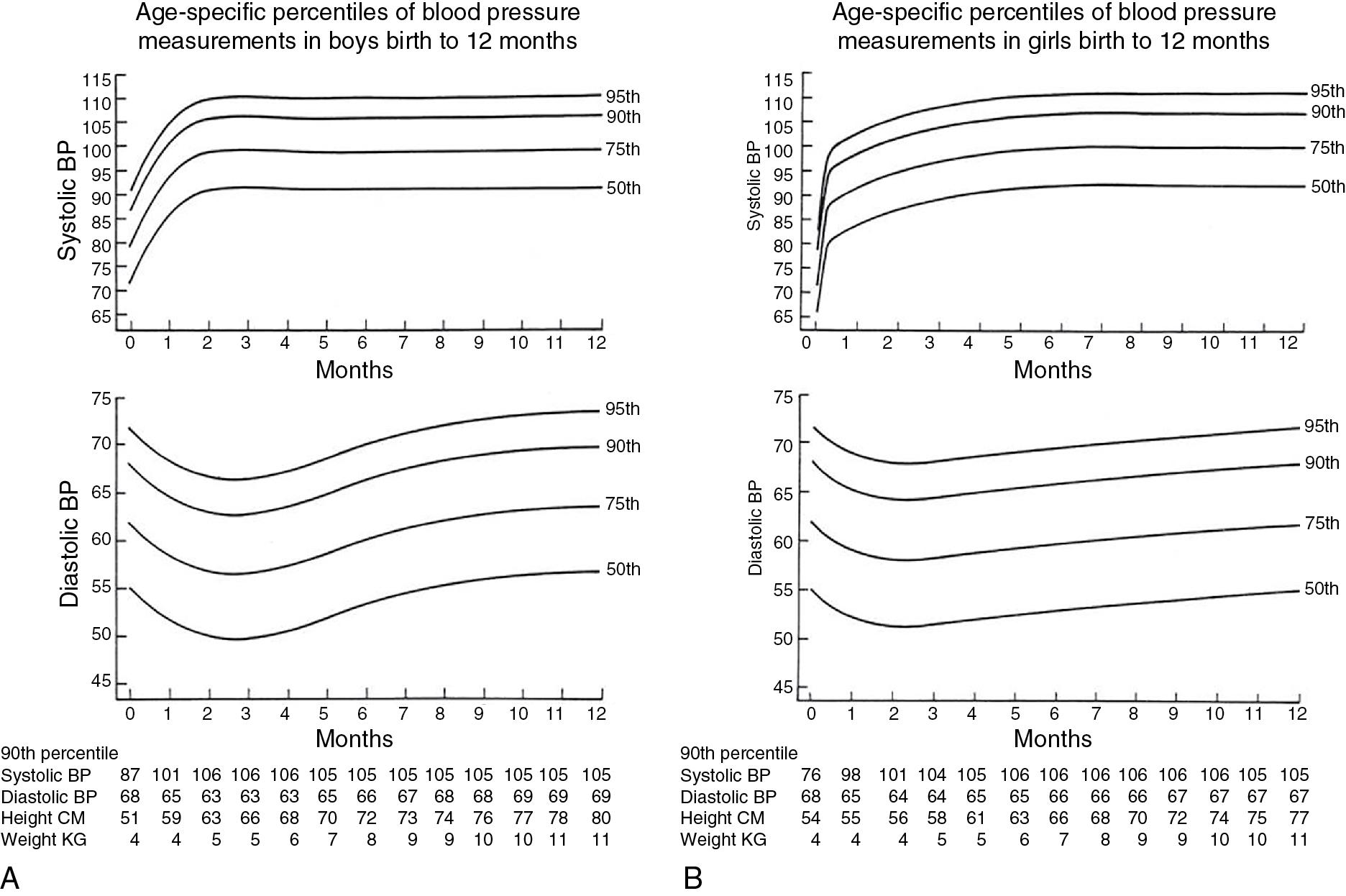
In older children, the definition of hypertension is persistent systolic and/or diastolic BP equal to or greater than the 95th percentile for age, sex, and height. As can be deduced from the preceding discussion, there is considerable variation in neonatal BP, and no generally agreed upon reference values are available. For term infants and infants between 1 and 12 months of age, the best available reference data, even despite the potential flaws noted earlier, would be those from the Second Task Force Report (see Fig. 16.5 ). In this age group, one could diagnose hypertension if the infant’s BP is repeatedly greater than or equal to the 95th percentile for an infant of comparable age (also note that weight and length are given below the curves and could also be used to help determine if an infant’s BP is normal or high).
The major unresolved question is what BP values to use in diagnosing hypertension in preterm infants. Dionne and colleagues combined published data (including from the studies mentioned previously) to derive a table of reference data for infants from 26 to 44 weeks’ postmenstrual ages ( Table 16.1 ) that contain reference values for the 50th, 95th, and 99th percentiles of mean arterial pressure and systolic and diastolic BP. Use of this table was endorsed in the 2017 AAP guideline. Using these data, our recommendation is that infants with BP values persistently at or above the 95th percentile warrant closer monitoring, and those with BP values above the 99th percentile would clearly merit investigation and possibly initiation of antihypertensive drug therapy. These decisions need to be tempered by clinical circumstances and personal experience.
| Postmenstrual Age | 50th Percentile | 95th Percentile | 99th Percentile |
|---|---|---|---|
| 44 Weeks | |||
| SBP | 88 | 105 | 110 |
| DBP | 50 | 68 | 73 |
| MAP | 63 | 80 | 85 |
| 42 Weeks | |||
| SBP | 85 | 98 | 102 |
| DBP | 50 | 65 | 70 |
| MAP | 62 | 76 | 81 |
| 40 Weeks | |||
| SBP | 80 | 95 | 100 |
| DBP | 50 | 65 | 70 |
| MAP | 60 | 75 | 80 |
| 38 Weeks | |||
| SBP | 75 | 90 | 95 |
| DBP | 45 | 60 | 65 |
| MAP | 55 | 70 | 75 |
| 36 Weeks | |||
| SBP | 70 | 85 | 90 |
| DBP | 40 | 55 | 60 |
| MAP | 50 | 65 | 70 |
| 34 Weeks | |||
| SBP | 68 | 83 | 88 |
| DBP | 40 | 55 | 60 |
| MAP | 48 | 62 | 69 |
| 32 Weeks | |||
| SBP | 65 | 80 | 85 |
| DBP | 40 | 55 | 60 |
| MAP | 48 | 65 | 68 |
| 30 Weeks | |||
| SBP | 60 | 75 | 80 |
| DBP | 38 | 50 | 54 |
| MAP | 45 | 58 | 63 |
| 28 Weeks | |||
| SBP | 55 | 72 | 77 |
| DBP | 30 | 50 | 56 |
| MAP | 38 | 57 | 63 |
| 26 Weeks | |||
| SBP | 50 | 70 | 76 |
| DBP | 30 | 48 | 53 |
| MAP | 38 | 55 | 61 |
Become a Clinical Tree membership for Full access and enjoy Unlimited articles
If you are a member. Log in here